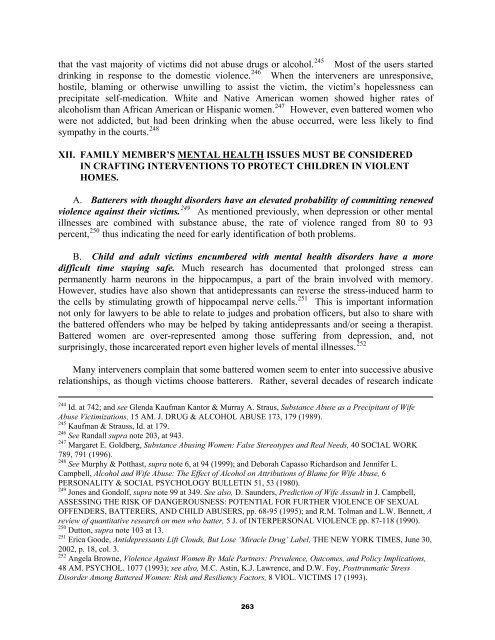A Judge’s Guide
A Judge’s Guide
A Judge’s Guide
Create successful ePaper yourself
Turn your PDF publications into a flip-book with our unique Google optimized e-Paper software.
that the vast majority of victims did not abuse drugs or alcohol. 245 Most of the users started<br />
drinking in response to the domestic violence. 246 When the interveners are unresponsive,<br />
hostile, blaming or otherwise unwilling to assist the victim, the victim’s hopelessness can<br />
precipitate self-medication. White and Native American women showed higher rates of<br />
alcoholism than African American or Hispanic women. 247 However, even battered women who<br />
were not addicted, but had been drinking when the abuse occurred, were less likely to find<br />
sympathy in the courts. 248<br />
XII. FAMILY MEMBER’S MENTAL HEALTH ISSUES MUST BE CONSIDERED<br />
IN CRAFTING INTERVENTIONS TO PROTECT CHILDREN IN VIOLENT<br />
HOMES.<br />
A. Batterers with thought disorders have an elevated probability of committing renewed<br />
violence against their victims. 249 As mentioned previously, when depression or other mental<br />
illnesses are combined with substance abuse, the rate of violence ranged from 80 to 93<br />
percent, 250 thus indicating the need for early identification of both problems.<br />
B. Child and adult victims encumbered with mental health disorders have a more<br />
difficult time staying safe. Much research has documented that prolonged stress can<br />
permanently harm neurons in the hippocampus, a part of the brain involved with memory.<br />
However, studies have also shown that antidepressants can reverse the stress-induced harm to<br />
the cells by stimulating growth of hippocampal nerve cells. 251 This is important information<br />
not only for lawyers to be able to relate to judges and probation officers, but also to share with<br />
the battered offenders who may be helped by taking antidepressants and/or seeing a therapist.<br />
Battered women are over-represented among those suffering from depression, and, not<br />
surprisingly, those incarcerated report even higher levels of mental illnesses. 252<br />
Many interveners complain that some battered women seem to enter into successive abusive<br />
relationships, as though victims choose batterers. Rather, several decades of research indicate<br />
244<br />
Id. at 742; and see Glenda Kaufman Kantor & Murray A. Straus, Substance Abuse as a Precipitant of Wife<br />
Abuse Victimizations, 15 AM. J. DRUG & ALCOHOL ABUSE 173, 179 (1989).<br />
245<br />
Kaufman & Strauss, Id. at 179.<br />
246<br />
See Randall supra note 203, at 943.<br />
247<br />
Margaret E. Goldberg, Substance Abusing Women: False Stereotypes and Real Needs, 40 SOCIAL WORK<br />
789, 791 (1996).<br />
248 See Murphy & Potthast, supra note 6, at 94 (1999); and Deborah Capasso Richardson and Jennifer L.<br />
Campbell, Alcohol and Wife Abuse: The Effect of Alcohol on Attributions of Blame for Wife Abuse, 6<br />
PERSONALITY & SOCIAL PSYCHOLOGY BULLETIN 51, 53 (1980).<br />
249 Jones and Gondolf, supra note 99 at 349. See also, D. Saunders, Prediction of Wife Assault in J. Campbell,<br />
ASSESSING THE RISK OF DANGEROUSNESS: POTENTIAL FOR FURTHER VIOLENCE OF SEXUAL<br />
OFFENDERS, BATTERERS, AND CHILD ABUSERS, pp. 68-95 (1995); and R.M. Tolman and L.W. Bennett, A<br />
review of quantitative research on men who batter, 5 J. of INTERPERSONAL VIOLENCE pp. 87-118 (1990).<br />
250 Dutton, supra note 103 at 13.<br />
251 Erica Goode, Antidepressants Lift Clouds, But Lose ‘Miracle Drug’ Label, THE NEW YORK TIMES, June 30,<br />
2002, p. 18, col. 3.<br />
252 Angela Browne, Violence Against Women By Male Partners: Prevalence, Outcomes, and Policy Implications,<br />
48 AM. PSYCHOL. 1077 (1993); see also, M.C. Astin, K.J. Lawrence, and D.W. Foy, Posttraumatic Stress<br />
Disorder Among Battered Women: Risk and Resiliency Factors, 8 VIOL. VICTIMS 17 (1993).<br />
263


